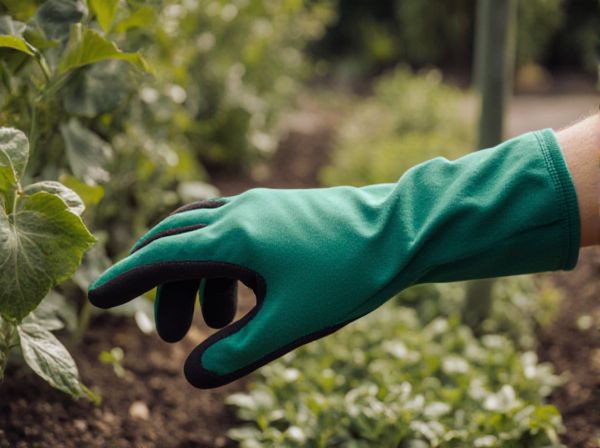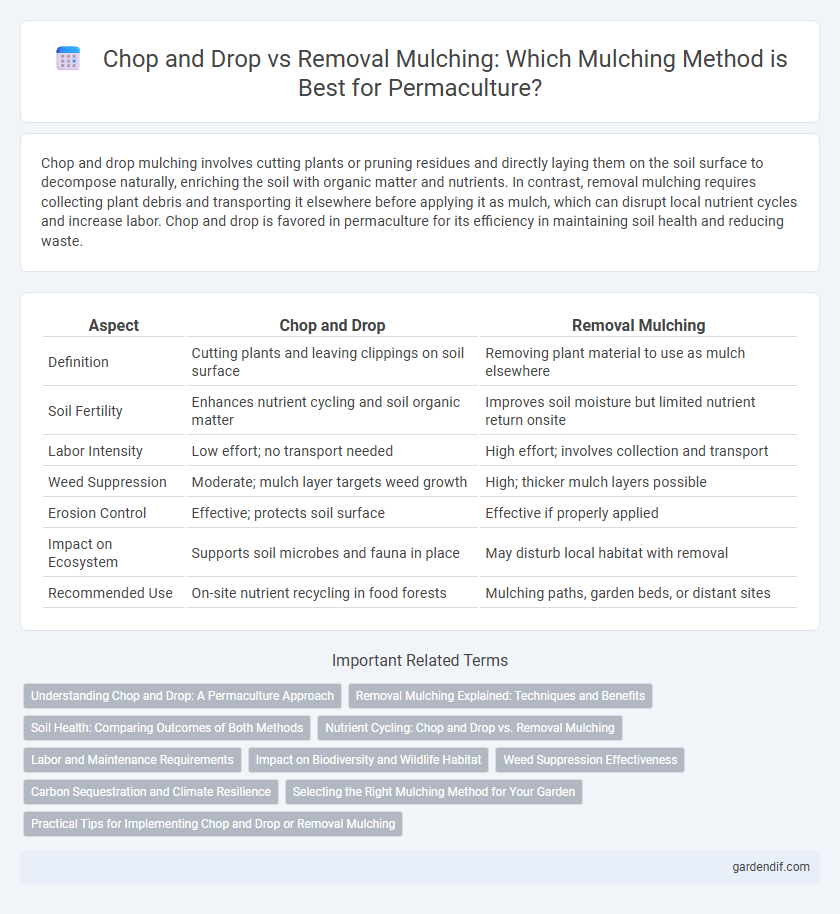
Chop and drop vs removal mulching Illustration
Chop and drop mulching involves cutting plants or pruning residues and directly laying them on the soil surface to decompose naturally, enriching the soil with organic matter and nutrients. In contrast, removal mulching requires collecting plant debris and transporting it elsewhere before applying it as mulch, which can disrupt local nutrient cycles and increase labor. Chop and drop is favored in permaculture for its efficiency in maintaining soil health and reducing waste.
Table of Comparison
| Aspect | Chop and Drop | Removal Mulching |
|---|---|---|
| Definition | Cutting plants and leaving clippings on soil surface | Removing plant material to use as mulch elsewhere |
| Soil Fertility | Enhances nutrient cycling and soil organic matter | Improves soil moisture but limited nutrient return onsite |
| Labor Intensity | Low effort; no transport needed | High effort; involves collection and transport |
| Weed Suppression | Moderate; mulch layer targets weed growth | High; thicker mulch layers possible |
| Erosion Control | Effective; protects soil surface | Effective if properly applied |
| Impact on Ecosystem | Supports soil microbes and fauna in place | May disturb local habitat with removal |
| Recommended Use | On-site nutrient recycling in food forests | Mulching paths, garden beds, or distant sites |
Understanding Chop and Drop: A Permaculture Approach
Chop and drop is a permaculture mulching technique where plant material is cut and left to decompose in place, enriching the soil with organic matter and nutrients. Unlike removal mulching, which involves transporting mulch from external sources, chop and drop utilizes on-site biomass, promoting soil health and reducing labor and waste. This approach supports natural nutrient cycling, enhances moisture retention, and fosters beneficial microbial activity in permaculture systems.
Removal Mulching Explained: Techniques and Benefits
Removal mulching in permaculture involves physically transporting organic material away from the site to control pests, diseases, or invasive species, enhancing soil health by preventing nutrient imbalances. Techniques include cutting unwanted vegetation and carefully removing it, which reduces competition for resources and allows desirable plants to thrive. This method supports long-term ecosystem resilience by promoting biodiversity and improving soil structure through targeted organic matter management.
Soil Health: Comparing Outcomes of Both Methods
Chop and drop mulching enriches soil health by decomposing organic matter in place, fostering microbial activity and enhancing nutrient cycling. Removal mulching, while effective at weed suppression, can deplete soil nutrients if plant material is removed and not returned to the ecosystem. Studies show chop and drop methods improve soil structure and moisture retention more consistently than removal mulching, promoting sustainable soil fertility in permaculture systems.
Nutrient Cycling: Chop and Drop vs. Removal Mulching
Chop and drop mulching enhances nutrient cycling by decomposing organic matter directly on-site, returning essential nutrients like nitrogen, phosphorus, and potassium to the soil swiftly. Removal mulching, which involves clearing biomass from the area, reduces immediate nutrient availability but can prevent pest buildup and disease. Integrating chop and drop practices promotes soil fertility and microbial activity, fostering a sustainable nutrient loop in permaculture systems.
Labor and Maintenance Requirements
Chop and drop mulching significantly reduces labor by allowing plant material to decompose naturally on-site, minimizing the need for external inputs and frequent upkeep. Removal mulching requires more intensive labor for gathering, transporting, and applying organic matter, often leading to higher maintenance to ensure mulch remains effective. Over time, chop and drop systems create self-sustaining soil enrichment, whereas removal mulching demands continuous management to maintain soil health.
Impact on Biodiversity and Wildlife Habitat
Chop and drop mulching enhances biodiversity by providing continuous organic matter that supports soil organisms, insects, and ground-dwelling wildlife, fostering a rich habitat within permaculture systems. Removal mulching, although reducing surface cover temporarily, can disrupt habitats by disturbing soil fauna and decreasing food sources for beneficial insects and small animals. Maintaining in-situ vegetation with chop and drop practices promotes ecological balance and sustains wildlife corridors critical for ecosystem resilience.
Weed Suppression Effectiveness
Chop and drop mulching improves weed suppression by leaving a dense organic layer that blocks sunlight and prevents weed seed germination naturally. Removal mulching, while effective at clearing existing weeds, often leaves bare soil exposed, increasing vulnerability to new weed growth. Consistent application of chop and drop techniques enhances soil health and creates a self-sustaining mulch barrier that outperforms removal mulching in long-term weed control.
Carbon Sequestration and Climate Resilience
Chop and drop mulching enhances carbon sequestration by allowing organic matter to decompose in place, enriching soil carbon content and boosting microbial activity critical for climate resilience. Removal mulching, while reducing surface residues, often leads to lower soil organic carbon, diminishing a system's ability to sequester carbon and retain moisture. Integrating chop and drop practices fosters continuous carbon input and improves soil structure, increasing ecosystem stability under changing climate conditions.
Selecting the Right Mulching Method for Your Garden
Selecting the right mulching method for your permaculture garden significantly impacts soil health and plant growth. Chop and drop mulching enriches the soil by allowing cut plant material to decompose naturally, enhancing nutrient cycling and moisture retention without disturbing soil structure. In contrast, removal mulching involves cutting and removing biomass, which can help prevent pest buildup but may require additional inputs to maintain soil fertility.
Practical Tips for Implementing Chop and Drop or Removal Mulching
Chop and drop mulching involves cutting plants and leaving the biomass directly on the soil surface to decompose, enhancing soil fertility and moisture retention with minimal labor and disturbance. Removal mulching requires collecting plant material and spreading it as a separate mulch layer, which may improve pest control and aesthetic but demands more time and effort. Practical tips for chop and drop include using nitrogen-rich green matter and timing cuts before flowering, while removal mulching benefits from shredding material to speed decomposition and applying mulch evenly around plant bases to prevent rot.
Chop and drop vs removal mulching Infographic

 gardendif.com
gardendif.com